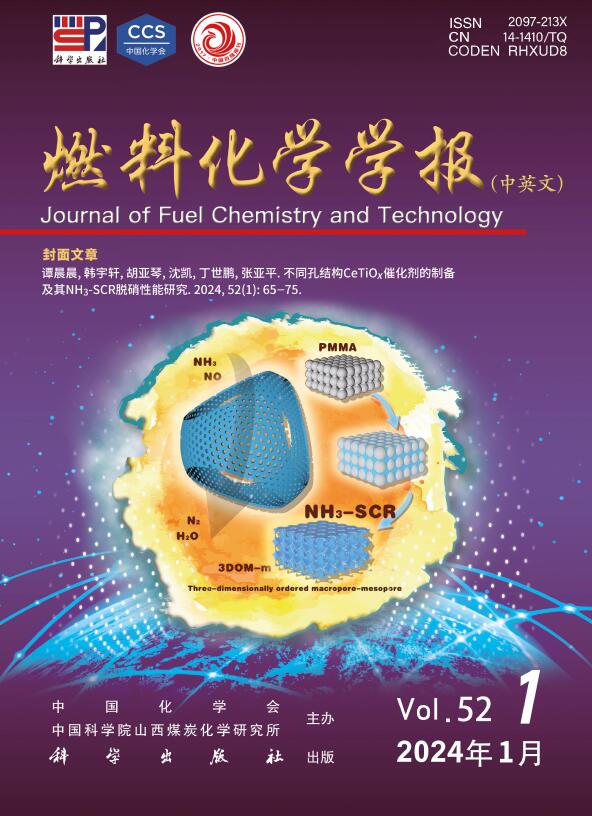改性ZnZrOx与ZSM-5偶联作为CO2加氢制芳烃的催化剂
Q3 Energy
引用次数: 0
摘要
近年来,在氧化沸石双功能催化剂上通过甲醇介导的途径将CO2直接加氢生成芳烃的研究受到了广泛的关注。然而,由于CO2的化学惰性,在温和条件下活化CO2仍然是一个很大的挑战,因为它需要克服很高的活化能垒。本文采用一系列过渡金属(M = Fe, Cu, Co, Ni)对ZnZrOx氧化物进行改性,并将改性后的M-ZnZrOx氧化物与ZSM-5分子筛结合使用,组成双功能的M-ZnZrOx/ZSM-5复合催化剂,用于CO2直接加氢制芳烃。结果表明:铁改性的Fe-ZnZrOx/ZSM-5催化剂具有丰富的氧空位,有利于CO2转化为芳烃;在275℃、H2/CO2 = 3、空速600 mL/(g·h)条件下,Fe质量分数为4%的Fe(4)-ZnZrOx/ZSM-5催化剂对芳烃的选择性为80.4%,其中四甲基苯的选择性大于70.4%,单次CO2转化率为5.6%。当铁含量进一步增加到8%时,对芳烃的选择性也提高了85.0%。这样的观察结果对于设计工业催化剂将二氧化碳直接转化为芳烃是有用的。本文章由计算机程序翻译,如有差异,请以英文原文为准。
Modified ZnZrOx coupled with ZSM-5 as the catalyst for the hydrogenation of CO2 to aromatics
Direct hydrogenation of CO2 to aromatics via the methanol-mediated route over an oxide-zeolite bifunctional catalyst has received considerable attention in recent years. However, the activation of CO2 at mild condition remains a great challenge, as it needs to conquer a high activation energy barrier due to the chemical inertness of CO2. Herein, ZnZrOx oxides were modified by a series of transition metals (M = Fe, Cu, Co, Ni) and the modified M-ZnZrOx oxides were further used together with the commercial ZSM-5 zeolite to comprise the bifunctional M-ZnZrOx/ZSM-5 composite catalysts for the direct hydrogenation of CO2 to aromatics. The results indicate that the iron-modified Fe-ZnZrOx/ZSM-5 catalysts have abundant oxygen vacancies which are active for the transformation CO2 to aromatics; under 275 °C, H2/CO2 = 3, and a space velocity of 600 mL/(g·h), the Fe(4)-ZnZrOx/ZSM-5 catalyst with an Fe mass fraction of 4% achieves a selectivity of 80.4% to aromatics, where tetramethylbenzene accounts for more than 70.4%, with a single-pass CO2 conversion of 5.6%. A further increase of the Fe content to 8% can even improve the selectivity to aromatics (85.0%). Such observation should be useful for the design of industrial catalysts efficient for the direct conversion of CO2 to aromatics.
求助全文
通过发布文献求助,成功后即可免费获取论文全文。
去求助
来源期刊

燃料化学学报
Chemical Engineering-Chemical Engineering (all)
CiteScore
2.80
自引率
0.00%
发文量
5825
期刊介绍:
Journal of Fuel Chemistry and Technology (Ranliao Huaxue Xuebao) is a Chinese Academy of Sciences(CAS) journal started in 1956, sponsored by the Chinese Chemical Society and the Institute of Coal Chemistry, Chinese Academy of Sciences(CAS). The journal is published bimonthly by Science Press in China and widely distributed in about 20 countries. Journal of Fuel Chemistry and Technology publishes reports of both basic and applied research in the chemistry and chemical engineering of many energy sources, including that involved in the nature, processing and utilization of coal, petroleum, oil shale, natural gas, biomass and synfuels, as well as related subjects of increasing interest such as C1 chemistry, pollutions control and new catalytic materials. Types of publications include original research articles, short communications, research notes and reviews. Both domestic and international contributors are welcome. Manuscripts written in Chinese or English will be accepted. Additional English titles, abstracts and key words should be included in Chinese manuscripts. All manuscripts are subject to critical review by the editorial committee, which is composed of about 10 foreign and 50 Chinese experts in fuel science. Journal of Fuel Chemistry and Technology has been a source of primary research work in fuel chemistry as a Chinese core scientific periodical.
 求助内容:
求助内容: 应助结果提醒方式:
应助结果提醒方式:


